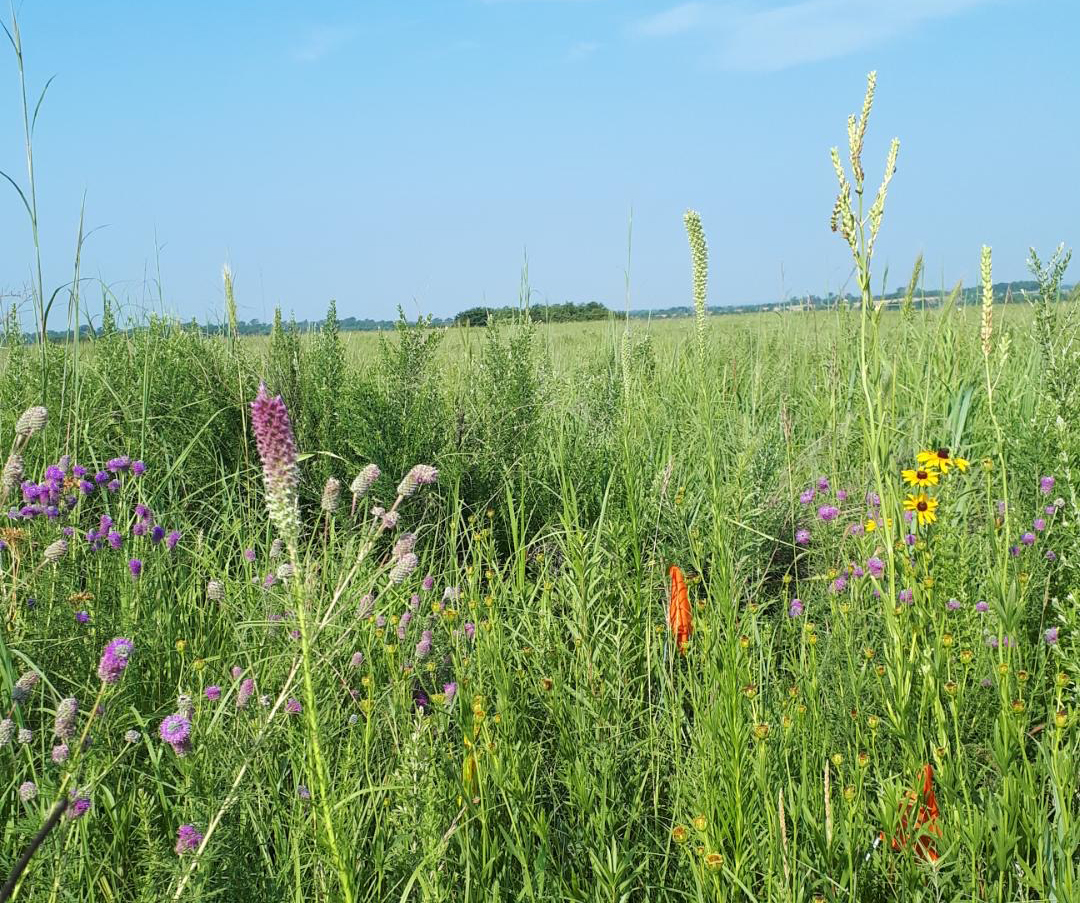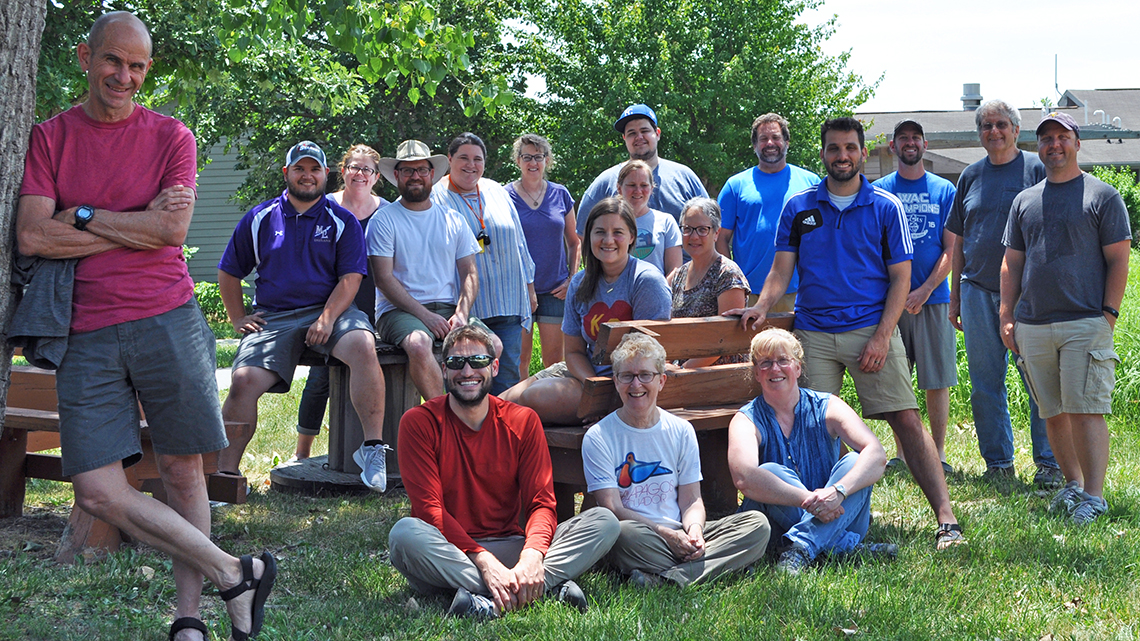Understanding Our Environment

July 2020 Issue
Understanding Our Environment is the internal newsletter for the Kansas Biological Survey & Center for Ecological Research community. Please email biosurvey@ku.edu regarding any errors or omissions.
Photo: An undergraduate researcher at a long-term field study site at the KU Field Station.
Comings and Goings
Tanya Semenova-Nelson recently left our research center and moved to Philadelphia to take a new scientist position there. She had been offered a fellowship by the American Association of University Women but ultimately declined it to take her new position. Tanya joined the Sikes Microbial Lab as a postdoctoral researcher in 2017; she will remain an affiliate and hopes colleagues will visit her and her family when travel is safe. Ben is an associate scientist and an associate professor in ecology and evolutionary biology (EEB).
Alex Martin will begin as a graduate student with Mark Mort, professor of EEB, this fall and is working this summer with Ted Harris, assistant research professor. Alex is unrecognizably at right in the photo below of the crew at the KU Field Station’s Cross Reservoir last week. Thanks to Debbie Baker, assistant director of our research center's Central Plains Center for BioAssessment, for this photo.
Publications
Theo Michaels’s paper, “A nucleation framework for transition between alternate states: Short-circuiting barriers to ecosystem recovery,” has been published in the journal Ecology. The paper presents a new framework for understanding plant community restoration. Co-authors are Maarten Eppinga and Jim Bever. Theo is a doctoral student in EEB with advisors Jim Bever and Ben Sikes. Jim is Foundation Distinguished Professor in EEB and a Bio Survey senior scientist. Theo took the photo below at one of her research sites at the Field Station’s Anderson County Prairie Preserve, a Nature Conservancy site.
A paper by Tom McKenna, along with co-authors Liz Koziol, Jim Bever, Tim Crews (The Land Institute) and Ben Sikes, “Abiotic and biotic context dependency of perennial crop yield,” has been published in the journal PLOS ONE. Tom is a Bio Survey assistant research professor; Liz is a postdoctoral researcher in the Bever/Schultz Lab.
Jude Kastens is co-author of a paper, “Trait-based aerial dispersal of arbuscular mycorrhizal fungi,” published in the journal New Phytologist. The lead author is V. Bala Chaudhary of DePaul University; other co-authors are Sarah Nolimal, Moises A. Sosa-Hernandez and Cameron Egan. Jude is a Bio Survey associate research professor. The journal’s website carries a story summarizing the research, along with photos.
Jacob Hopkins’s paper, “Frequent fire slows microbial decomposition of newly deposited fine fuels in a pyrophilic ecosystem,” has been accepted by the journal Oecologia. The paper focuses on how repeated fires can impact the decomposition of new fuels by microbes. The work was done at the Wade Tract, an old-growth pine savanna near the Florida-Georgia border. Jacob is a doctoral student in EEB and a member of the Sikes Microbial Lab (Ben Sikes).
Sharon Billings and Ligia Souza, a Ph.D. candidate in the Billings Lab, have a News & Views essay in press at Nature Geoscience describing the importance of a recent paper in that journal. Their essay will be published in the next issue, and Sharon will share a PDF.
Awards
Helen Alexander and Julie Schwarting have received the Educator Award of the Kansas Association for Conservation & Environmental Education (KACEE) for their development of the 1.4-acre demonstration prairie restoration at the old football field site at Lawrence Free State High School. Helen is a professor of EEB, a member of the KU Field Station Executive Committee and a Bio Survey affiliate. Julie is a biology and environmental science teacher at Free State. The listing on the association’s website acknowledges the support of the Kansas Biological Survey for the project; many Bio Survey scientists and staff contributed in various ways.
Amy Hammett also received an Educator Award from KACEE. In June 2018, Amy was part of the first group of Kansas high school science teachers (group shot below) to participate in the Ecosystems of Kansas Summer Institute, a week-long program to learn about current research that links to K-12 science standards. The program was developed and is overseen by Peggy Schultz, Bio Survey researcher and a faculty member in the Environmental Studies Program. The institute is funded through a portion of the $20M NSF EPSCoR MAPS grant (Microbiomes of Aquatic, Plant, and Soil Systems across Kansas) based at KU. Amy is a Kansas State Dept. of Education Master Science Teacher at Maize High School, where she leads the Climate Club in monitoring Cheney Reservoir for harmful algal blooms (HABs), in partnership with the City of Wichita, the U.S. Geological Survey, the Kansas Water Office and the University of Missouri’s Reservoir Observer Student Scientist program—a project directly influenced by her participation in the Summer Institute. 
Search for new BI director
Sara Baer, Bio Survey director and professor of EEB, will chair the search committee for the next director of the Biodiversity Institute & Natural History Museum. This will be a newly endowed position, and a new director, who will build on the work of retiring director Kris Kristalka, will be named in 2021.
Publicity
The Kansas Land Trust has posted a YouTube video of Kelly Kindscher, Bio Survey senior scientist and professor in the Environmental Studies Program, giving a tour at the Akin Prairie, one of the prized native prairie remnants in Douglas County.
KU Field Station
KU photographers last week gathered both still and video images (including the one at the top of this page) at the KU Field Station, including permitted drone footage at two long-term field research sites (Foster Research Lab site and Dimensions site), and interviews with faculty scientists and students. They also gathered footage of projects at the greenhouse complex and the Native Medicinal Plant Garden. They plan to visit the Anderson County Prairie Preserve early next week. This footage, along with other footage gathered the past two years, will be used in the development of a video about the Field Station. The photographers are part of the KU Marketing Communications staff and are following the University’s strict safety protocols.